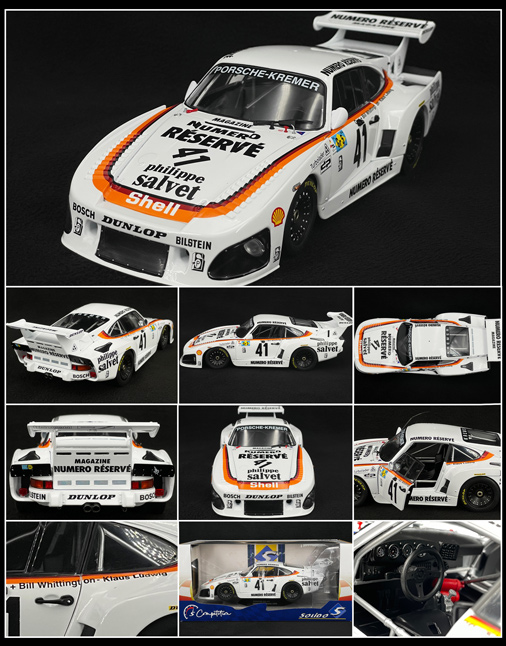|
Porsche 935 K3 n°41
Winner 24h Le Mans 1979 - 1 : 18
Founded in 1962 in Cologne, brothers Manfred and Erwin Kremers' team rapidly specialized in the preparation of Porsches for competition. Thanks to their Porsche 911, 914-6 and 934, they began to accumulate successes, until the arrival of the Porsche 935 in 1976.
That was a real revelation, an 'affair of the heart' for the two brothers, who from 1977 developed their own versions of the car: K1, K2 and K3. The latter, an optimization of the official Porsche Moby Dick, proved to be as reliable as it was powerful, and enabled the Kremer Racing Team to win the 1979 edition of the Le Mans 24 hours. The factory driver, Klaus Ludwig, won the first of his three Le Mans victories in driving rain.
The car, sold to the Whittington brothers just a few hours before the start of the race, was considerably lighter in weight and had a power output of 740 to 800 horsepower thanks to a 3.2-liter twin-turbocharged flat 6. The Kremer brothers' modifications were later marketed as a kit that allowed many teams to develop their own versions of the Porsche 935, with considerable successes on circuits around the world.
The Kremer brothers made a huge contribution to the Porsche 935 history, one of the most successful racing cars in the history of the automobile, boasting an outstanding longevity.
1962 in Köln gegründet, spezialisierte sich das Team der Brüder Manfred und Erwin Kremer schnell auf die Rennvorbereitung von Porsche. Dank ihrer Porsche 911, 914-6 und 934 begannen sie Erfolge zu sammeln, bis 1976 der Porsche 935 auf den Markt kam.
Es war ein echter Schwarm und eine Offenbarung für die beiden Brüder, die ab 1977 ihre eigenen Versionen des Autos entwickelten: K1, K2, dann K3. Letzterer, eine Optimierung des offiziellen Porsche Moby Dick, erwies sich als ebenso zuverlässig wie effizient und ermöglichte dem Kremer Racing Team 1979 den Sieg bei den 24 Stunden von Le Mans. Und der Werksfahrer Klaus Ludwig holte sich bei strömendem Regen den ersten seiner drei Siege in Le Mans.
Das Auto, das wenige Stunden vor Beginn der Veranstaltung an die Brüder Whittington verkauft wurde, profitierte von einem deutlich geringeren Gewicht und einer Leistung von 740 bis 800 PS dank eines 3,2-Liter-Biturbo-6-Zylinder-Boxermotors. Die Modifikationen der Gebrüder Kremer werden dann in Form eines Bausatzes vermarktet, der es vielen Teams ermöglicht, ihre eigenen Versionen des Porsche 935 zu entwickeln, mit vielen Erfolgen auf den Rennstrecken der ganzen Welt.
Ein großer Beitrag der Gebrüder Kremer also zum Mythos des Porsche 935, einem der Rennwagen mit der umfangreichsten Erfolgsbilanz der Automobilgeschichte und außergewöhnlicher Langlebigkeit.
Fondée en 1962 à Cologne, l'écurie des frères Manfred et Erwin Kremer se spécialise rapidement dans la préparation des Porsches pour la compétition. Grâce à leurs Porsche 911, 914-6 et 934 ils commencent à accumuler les succès, jusqu'à l'arrivée de la Porsche 935 en 1976.
C'est un véritable coup de cœur et une révélation pour les deux frères, qui dès 1977 développent leurs propres versions de la voiture : K1, K2 puis K3. Cette dernière, une optimisation de la Moby Dick officielle de Porsche, se révèle aussi fiable que performante, et permet au Kremer Racing Team de remporter l'édition 1979 des 24h du Mans. Ainsi qu'au pilote d'usine Klaus Ludwig de remporter la première de ses trois victoires au Mans, sous une pluis battante.
La voiture, vendue aux frères Whittington quelques heures à peine avant le début de l'épreuve, bénéficiait d'un poids considérablement allégé et d'une puissance de 740 à 800 chevaux grâce à un flat 6 biturbo de 3.2 litres de cylindrée. Les modifications des frères Kremer seront par la suite commercialisées sous forme d'un kit qui permettra à de nombreuses écuries de développer leurs propres versions de la Porsche 935, avec de nombreux succès à la clé sur les circuits du monde entier.
Une grande contribution donc des frères Kremer à la légende de la Porsche 935, une des voitures de course au palmarès le plus fourni de l'histoire automobile, et à la longévité exceptionnelle.
|




